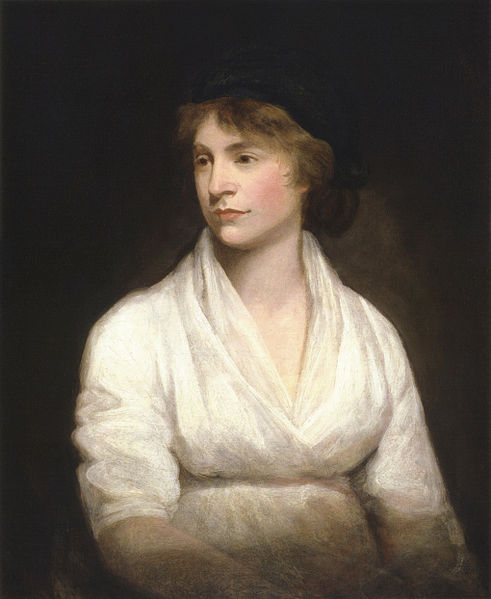The Manufactured Female Gender: Mary Wollstonecraft

Critical analysis of an excerpt from the second chapter of Mary Wollstonecraft’s A Vindication of the Rights of Woman suggests that the author is writing on behalf of the notion that both sexes have an inherently equal capacity to reason, but that women are forced into subordination by the stereotypes and characterizations that are projected onto them by patriarchal authority and social structures. The specific section of text to be discussed offers rich discourse on the notion of the socially imposed identity that women are forced to assume rather than being allowed to embrace the innate human qualities that they are born with.
One device that excludes women from acceptance as reasonable beings is to alienate them from their innate capacity for said reasoning. From the time they are born, women learn from their mothers that they need not think and reason, only perfect their social graces and physical appearance in order to ensure that they will find husbands to take care of them (Wollstonecraft 586). Women are then unable to gain a real understanding of themselves as people and instead accept, from birth, what society tells them that women should strive to be. Therefore, the nature of women is limited to the stereotypical feminine traits that society ascribes to them, and they are unable to understand the human identity possessed by all people that transcends the physical differences between the sexes.
Wollstonecraft describes these gender traits as prejudiced notions of gender identity and asserts that a person can never obtain stability until such walls come down and the reasoning soul is freed from the body that society has conditioned to take precedence over true understanding (Wollstonecraft 586). Susan Manly draws upon previous interpretations of Wollstonecraft to make a point that perfectly symbolizes the limitations that women have imposed upon them in her claim that Wollstonecraft suggests that “gender, if taken as definitive of personal and social identity, is a prison” (Manly 51). It is clear from this that the socially imposed notion of gender is something that Wollstonecraft believes to be instrumental in the binding of the female sex to a manufactured identity.
To help clarify the source of this prejudice and imposed gender identity, one may consider Wollstonecraft’s relating the situation of women in society to that of military men. Before concluding that these two groups of people have fundamental similarities, Wollstonecraft asserts that “they both acquire manners before morals, and a knowledge of life before they have, from reflection, any acquaintance with the grand ideal outline of human nature” (Wollstonecraft 590). This is another perspective on the situation of women being denied the opportunity to develop reasonable thought and they are instead limited to their socially implemented gender identity. Linda Kauffman addresses this issue in her assertion that “Wollstonecraft found the distinguishing human characteristic to be the familiar one of reason, and the distinguishing female characteristic to be that of childbirth” (24-5). We see in this specific example that women are excluded from the realm of reasoning by their physical role as child bearers. In this case, “woman” becomes synonymous with “mother,” on the basis of her fundamental physical difference from man. The identity of mother is something that is stereotypically imposed on all women by society without unbiased regard to their universal human qualities and the fact that not all women can or want to be mothers just because it is one aspect of being a woman.
Wollstonecraft proposes that the solution to the issue of this form of prejudice is social reform. Changing the conduct of society as a whole is important for the sake of eliminating prejudice because “men and women must be educated, in a great degree, by the opinions and manners of the society they live in” (Wollstonecraft 588). It is because such a substantial amount of learning is obtained from observation of the surrounding social practices that one’s individual ability to reason must be allowed to develop in order to properly interpret what he or she learns from society, rather than blindly accept it.
Further discussion on the social structures in place that characterizes women as harbouring feminine stereotypes considers the idea of keeping their understanding of themselves out of the philosophical realm and limiting it to the physical realm “by cramping their understandings and sharpening their senses” (Wollstonecraft 589). The position women are put into when they are denied the opportunity to gain basic understanding leads them to rely on how they perceive themselves physically, making it much easier for society to control them with stereotypical notions of what a woman should be, since they are rendered unable to reason anything different beyond their five senses. Susan Manly aptly describes the phenomenon of the imposed social notions of gender on women in her assertion that Wollstonecraft “sets out to construct a model of non-gendered identity – one which will ultimately benefit men as well as women, since she sees both as degraded by sexualized and oppositional models of identity” (Manly 50). It is noted here by Manly that both sexes are harmed when one is categorized by prejudice and manufactured ideals, and that Wollstonecraft seeks to change this.
Wollstonecraft’s choice of words early in the second chapter of her vindication metaphorically encompasses the notion that ascribed gender identity takes over a woman’s own knowledge of her human self. She says that in order for women to transcend the identity imposed on them and to obtain an understanding of themselves as humans, “they must be permitted to turn to the fountain of light, and not forced to shape their course by the twinkling of a mere satellite” (Wollstonecraft 587). The metaphoric meaning of this is that women have to be allowed to look upon the sun for themselves rather than accept the small fraction of it that the moon reflects. The sun represents the basic understanding and reason of the individual while the moon represents the society that reflects these notions of personal understanding in a prejudiced, distorted, and incomplete way, resulting in a socially ascribed identity.
Interpretation of Mary Wollstonecraft’s text leads to the conclusion that she considers the female identity attached to women to be a social means of rendering them incapable of thinking critically about their place in society and therefore remaining unable to change it.
Works Cited
Kauffman, Linda. Gender and Theory: Dialogues on Feminist Criticism. New York: Basil Blackwell Ltd, 1989. Print.
Manly, Susan. “Mary Wollstonecraft and her legacy.” A History of Feminist Literary Criticism. Ed. Gill Plain and Susan Sellers. Cambridge: Cambridge University Press, 2007. 46-65. Print.
Wollstonecraft, Mary. “From A Vindication of the Rights of Woman: From Chapter II. The Prevailing Opinion of a Sexual Character Discussed.” The Norton Anthology of Theory and Criticism. Ed. Vincent B. Leitch. New York: W. W. Norton & Company, Inc., 2001. 586-593. Print.







